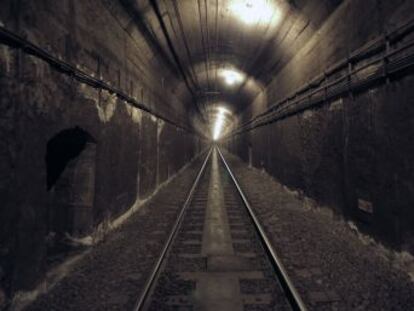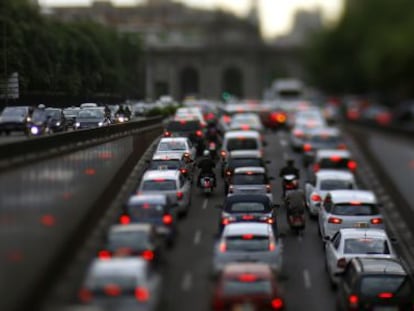Remembering Madrid’s golden age of trams
Long before the metro, the Spanish capital bustled with over 50 now-forgotten tram lines
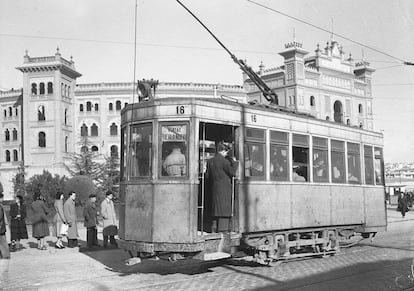

Roadworks in the Atocha neighborhood of Madrid have uncovered steel tracks – remnants of a time when the capital was ruled by trams. “There are actually lots of tracks under the streets because what they did when they got rid of this form of transportation was to simply throw concrete on top,” explains Álvaro Bonet, from the Madrid Cultural Heritage and Citizens Association. In the Ciudad Universitaria neighborhood, outside the Faro de Moncloa observation deck, a small section of the tram lines can still be seen. These are the only visible ones in the city. Yet for over a century, between 1871 and 1972, trams bustled through the Spanish capital. This is their story.
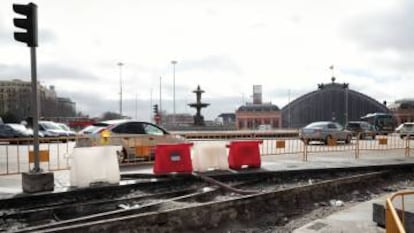
The first tram line opened on May 31, 1871 and connected Serrano Street with the Argüelles neighborhood, passing through Cibeles and Puerta del Sol, says Antonio Martínez, a historian and member of the Historical Metropolitan Society of Madrid. From this point on, the lines expanded unevenly and chaotically: “different private companies requested and obtained licenses,” explains Martínez, “each with their own trams, tracks and roundhouses.” According to the historian, 24 licenses were granted at the beginning of the 20th century.
The book Aquellos tranvías de Madrid (or Those trams of Madrid) by Diego Gutiérrez argues that “the history of trams in Madrid up until the end of the 19th century is the effort to link the city center with the periphery in all directions […] through different promoters, each with their own project.” The first trams were not exactly quiet. “There were two traction systems used: blood [donkey-drawn carriages] and steam; they looked more like a small train than a tram,” writes Gutiérrez.

But noise was not the only issue. With the arrival of electricity in 1898 came more problems: “The speed of electric carriages was far greater than before, and the number of crashes, many of them deadly, was considerable, sometimes leading to riots, like the one that happened in Puerta de Toledo when a tram ran over a boy and killed him,” reads a 1994 article by Carlos López Bustos, author of the book Tranvías de Madrid (Madrid Trams).
In the first years of the 20th century, almost all permits were controlled by the Société Générale de Belgique and later by other companies. The number of tram lines continued to grow, doubling from 25 in 1905 (although not all operated every day) to 50 in 1923, on which 471 trams ran daily. “The Civil War caused a huge blow to the network, leaving many trams destroyed,” explains Martínez.
After the conflict, efforts were made to fix some of the routes but the tram network could not be completely restored. It is difficult to know the total number of lines – many changed their number or route – but the tram numbers went up to 81. In 1947, the Municipal Transit Authority (EMT) was created to manage the trams, but gradually these were replaced with buses. “Public opinion maintained that the trams were an old relic that caused traffic delays,” says engineer Antonio Manuel Sanz. The carriages disappeared from Puerta de Sol in 1949 and from Plaza Mayor square in 1956.
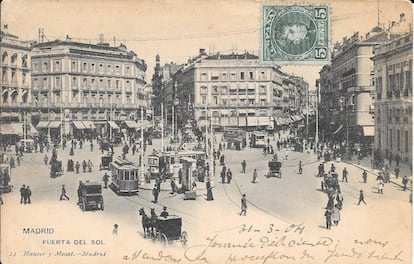
A spokesperson for EMT confirmed that the last two lines – Number 70 (which traveled between Plaza de Castilla and San Blas) and 77 (Pueblo Nuevo to Ciudad Pegaso) – took their last trip on June 1, 1972, exactly 101 years after they were launched. “We have saved two chunks of the tram lines in the EMT Museum,” the spokesperson added.
But in terms of the trams themselves, there is only one which has been conserved, and it can be seen at the metro station Pinar de Chamartín. The Historical Metropolitan Society of Madrid is hoping to open a museum at the old roundhouse in La Bombilla. But until then, the tracks revealed by the roadworks in Atocha are one of the few reminders of Madrid's not-so-distant past.
English version by Melissa Kitson.
Tu suscripción se está usando en otro dispositivo
¿Quieres añadir otro usuario a tu suscripción?
Si continúas leyendo en este dispositivo, no se podrá leer en el otro.
FlechaTu suscripción se está usando en otro dispositivo y solo puedes acceder a EL PAÍS desde un dispositivo a la vez.
Si quieres compartir tu cuenta, cambia tu suscripción a la modalidad Premium, así podrás añadir otro usuario. Cada uno accederá con su propia cuenta de email, lo que os permitirá personalizar vuestra experiencia en EL PAÍS.
¿Tienes una suscripción de empresa? Accede aquí para contratar más cuentas.
En el caso de no saber quién está usando tu cuenta, te recomendamos cambiar tu contraseña aquí.
Si decides continuar compartiendo tu cuenta, este mensaje se mostrará en tu dispositivo y en el de la otra persona que está usando tu cuenta de forma indefinida, afectando a tu experiencia de lectura. Puedes consultar aquí los términos y condiciones de la suscripción digital.
More information
Archived In
Últimas noticias
Maduro pleads not guilty before the federal court in New York: ‘I am still the president of Venezuela’
A new test can detect Alzheimer’s from a finger prick
UN team enters Sudanese city of El Fasher after paramilitary massacre: ‘It’s like a ghost town’
A recipe for resistance: Indigenous peoples politicize their struggles from the kitchen
Most viewed
- Gilles Lipovetsky: ‘If you want to live better and fall in love, take Prozac, don’t look to philosophy’
- Alain Aspect, Nobel laureate in physics: ‘Einstein was so smart that he would have had to recognize quantum entanglement’
- Alvin Hellerstein, a 92-year-old judge appointed by Bill Clinton, to preside over Maduro’s trial in New York
- Why oil has been at the center of Venezuela-US conflicts for decades
- Cuba confirms death of 32 of its citizens in the US attack against Venezuela
